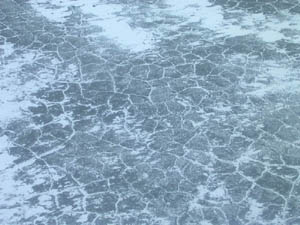 |
|
|
Home|Glossary|Links|Journal|Maps
These polygons are a type of patterned ground, which sometimes forms in cold places like Antarctica and the Arctic. The temperatures need to fluctuate above and below freezing, and there cannot be much vegetation to disrupt the pattern. If water in the soil begins to cool, it becomes denser until 4 degrees C and then less dense as ice crystals form. (Of course you knew that, because you know that ice floats on top of liquid water.) Water is unique in this way-- most other materials only get denser as they cool. In the soil, the frozen water and soil heaves up, trading places with the more dense water. The lines in the ground are depressions where the slightly warmer, more dense liquid water is sinking down…and bringing some soil with it. Oddly enough, the ground is somewhat like the surface of boiling water with convection cells. Areas where the water is rising up are higher, and areas where the water is sinking are lower. But this is happening a LOT slower than water boiling. It can take hundreds of years for the patterned ground to develop. Isn't it weird? - John |
